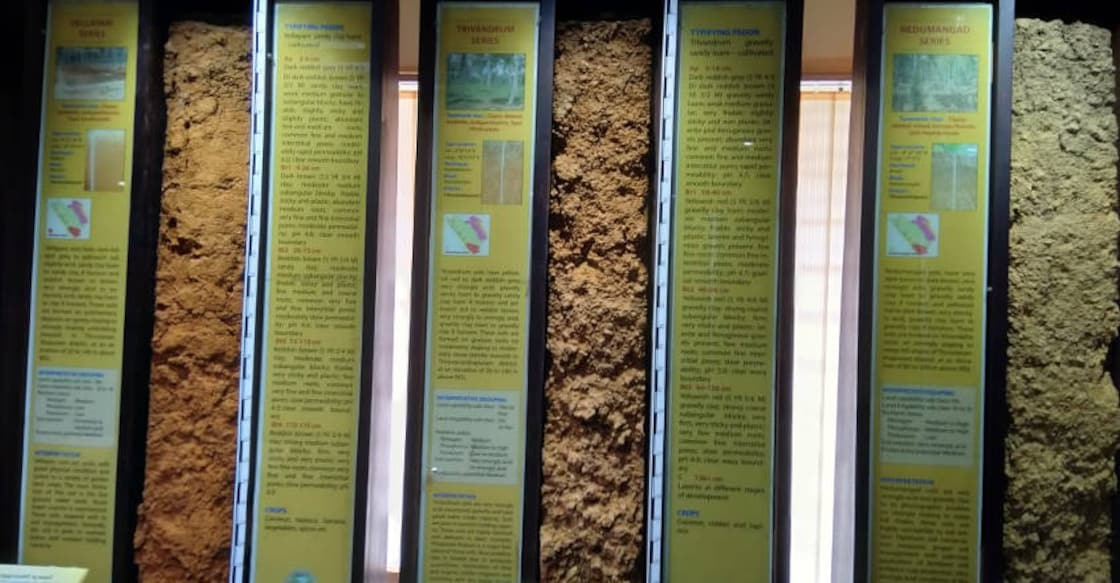Soil mysteries unveiled in India's first soil museum

Mail This Article
Thiruvananthapuram: When you take a stroll along the countryside be warned that you are trampling upon an entity with multiple personalities: the soil.
In Thiruvananthapuram district alone, right from the coast on the western side to Ponmudi in the east, there are 12 soil types. The number is conservative because it includes only 'benchmark soils', or soil types seen extensively in the district, and not the less common varieties.
The Soil Survey and Soil Conservation Department, after years of scientific study, has identified 84 'benchmark soil' varieties across the state. All of these soil types, each as distinct as the colours of a rainbow, are arranged in neat vertical blocks inside the country's first Soil Museum here. The soil varieties are displayed in tall 'almirah'-like structures with as much grandeur as gold in a jewellery shop. Each soil block, called the 'soil monolith', forms the centre of the 'almirah'. On the either sides of the monolith are detailed descriptions about the soil type. The 'almirahs' of each districts are grouped together.
Even within a district, the difference is stark. Take Thiruvananthapuram for instance. If the Vellayani soil is dark reddish grey, the Nedumangad soil is very dark to pale brown, and the Amaravila soil is saffron and, unlike the rest, a bit molten. Inside the soil house of the Museum the variety is so vivid that the place looks like a wild medley of colours.
However, the renovated Soil Museum, which was inaugurated on Monday, wants to do more than just showcase soils. “We want to give the public a practical understanding of soils, and also the applicability of soil conservation measures,” said Justin Mohan, the director of the Soil Survey Department.
So if one floor showcases soils, others illustrate various aspects of soil conservation. There are miniature models of all major soil conservation structures like earthern bund, graded bund, inward sloping bund, and live fencing. There is a model that demonstrates soil slippage, a phenomenon where a flat piece of real estate just drops down, as though the area was magically suspended mid air all this while and suddenly the spell had vanished. Two years ago nearly six square kilometres in Kannur had suddenly dropped down. Thankfully, the area was free of houses.
The Soil Survey director said his main target is children. “We want the next generation to be made aware of the need of soil conservation,” he said. There is a room where a working model of soil erosion is installed. It demonstrates how erosion happens, in stages. First comes the rain, how it scrapes the soil surface not covered by vegetation, how gradually holes are formed on the soil, how the water sneaks into these holes, and how the gullies are then formed, growing larger and larger till disaster strikes. Another room, using miniature models, demonstrates how soil pollution takes place. Certain models, like that of the four types of agricultural lands (Kuttanad, Pokkali, Kole and Kaipad), are illustrative.
Other rooms have lighted boards that are educative. If one describes what healthy soil is, another explains the factors affecting the soil's pH, yet another educates on ways to remove pesticide residues from harvested produce.

The Museum also houses a giant 'soil map' of Kerala in which regions are divided not as districts but as agroecological units (AEUs). There are 23 AEUs in the state, the areas falling under one AEU having almost similar soil and climate characteristics. Palakkad and Thrissur have the highest number of AEUs, which is another way of saying that these two districts have a profusion of climate and soil types when compared to other parts of the state.


